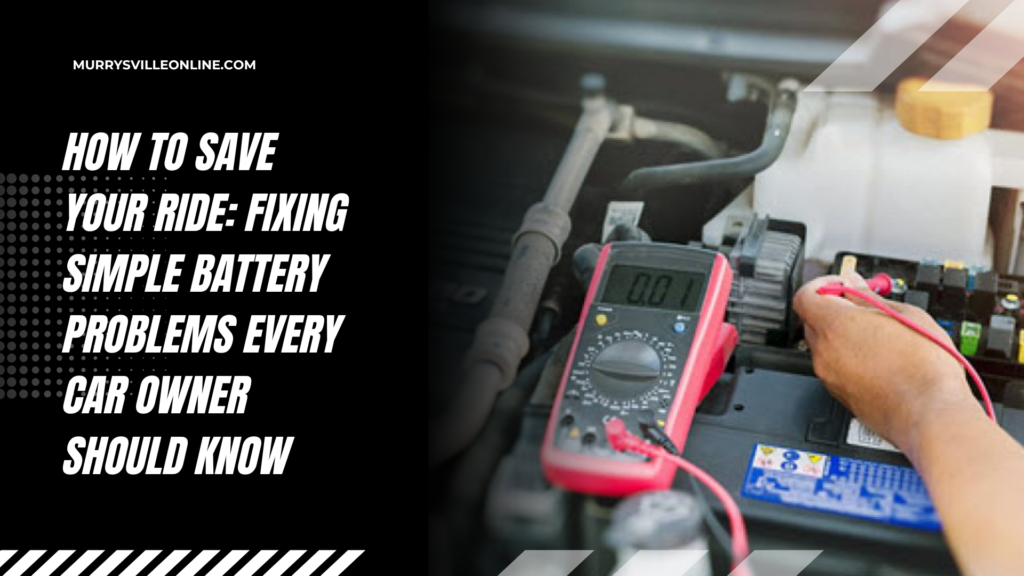
The battery in your car is the lifeblood of your electrical system, providing the juice to rotate the engine and energize vital accessories. Even the best batteries, however, will come to have problems in their own good time stranded at the most inopportune moment. Whether you’re a seasoned car owner or a novice when it comes to auto repair, knowing what the most common battery problems are and how to repair them will save you time, money, and aggravation. What follows are the most common battery problems and solutions that every car owner should know.
1. Dead Battery: The Old Favorite
The most common problem drivers face is a dead battery, which is usually caused by having headlights on, cold or hot weather, or an extremely old battery. If your car won’t start and you only hear a click, your battery is dead.
The quickest solution out of this is to jump-start your car with jumper cables and another car whose battery is in good condition. Connect cables properly—red to positive, black to negative—and drive the good car for a couple of minutes before attempting to start your car. If a car jump-start is successful, drive the car for 15-30 minutes or more to attempt to recharge the battery. If your battery keeps dying, however, replacement might be imminent.
2. Rusty Battery Terminals: The Silent Killer
Terminal corrosion can be a weak point in the battery-to-vehicle electrical system connection that would cause poor starting or electrical failure. It is usually caused by chemical reactions between metal terminals and battery acid.
To fix this issue, inspect your battery terminals for blue or white-green rust. If they’re rusted, disconnect the battery (begin with the negative terminal), scrub the terminals with a wire brush and baking soda solution and water and grease them up with petroleum jelly or a battery terminal cover so that they won’t rust in the future. Loose connections and eventual failure can be prevented with routine maintenance.
3. Battery Won’t Hold a Charge: A Red Flag
If the battery won’t hold a charge after a jump-start or extended drive, something’s amiss. A dead battery, parasitic drain, or bad alternator are suspects.
Check your battery’s age first—most car batteries only last 3 to 5 years. If your battery’s older, perhaps it’s time to purchase a new one. Second, attempt to test for parasitic drains by turning off the vehicle, disconnecting the negative cable, and checking with a multimeter if If it’s high reading, there is something in the vehicle draining the battery, such as a malfunctioning relay or interior light left on.
4. Extreme Weather Conditions: Either Too Cold or Too Hot
Weather also influences the performance of the battery. Cold weather makes the engine oil thicker and harder for the battery to turn over the engine, while hot weather leads to evaporation of the battery fluid that internally damages the battery.
5. Loose or Faulty Battery Cables: The Sneaky Problem
Loose or worn battery cables will cause intermittent start and electrical failure. Intermittent starting issue and dimming of lights when turning on the lights are the result of a loose connection if your vehicle is facing either of these issues.
Inspect cables visually for looseness, cracks, or fraying to troubleshoot the problem. Tighten loose connections and replace damaged cables if the problem continues. A secure connection will provide a steady stream of electricity, avoiding breakdown and repair costs down the road.
6. The Alternator Issue: When It’s Not the Battery’s Fault
It is easy to blame your startup problems on a dead battery, but the problem can be an alternator problem. The alternator charges the battery when the car is in use. Once it does fail, your new battery will die right away.
Red flags include a blinking headlight, blinking dashboard lights to signal something is amiss, or unusual noises coming from the hood. For testing the alternator, a multimeter is utilized—at operation of the vehicle, the reading must be 13.5-14.5 volts; anything less and the alternator must be replaced or repaired.
7. Leaking or Swollen Battery – Red Flag
A leaking or swollen battery is an emergency that should be addressed right away. It happens in most cases because of overcharging, heat, or internal failure.
If the battery is swelling on the sides or there is fluid leakage from the battery, stop using it right away. A swollen battery will burst and release harmful chemicals that can hurt you. Replace the battery right away and have your car’s charging system checked to avoid future overcharging.
8. Battery Light on Dashboard: Warning Signs You Shouldn’t Ignore
Whenever this occurs, never kill the engine until you arrive at a secure spot since your automobile will not budge. Your battery and charging system should be checked instantly so you can know what is amiss with it so that it may not lead to a breakdown.
Final Thoughts: Preventative Maintenance is Key
It is important to maintain your car battery in a healthy state for hassle-free and problem-free driving. Periodic inspection of corrosion, voltage check, and minor repair before they become major problems can avoid sudden breakdowns.
Understanding the following typical battery problems and how they are repaired will enable you to take better care of your vehicle. Whether it’s taking it in for regular service or being prepared to know when the time for replacement has arrived, a little knowledge is a great method of battery problems staying away. Treat your car well, and it will give you a good start each time!
